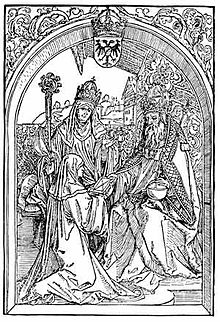Gerberga II, Abbess of Gandersheim
| Gerberga II | |
|---|---|

Hrotsvit of Gandersheim passes her Gesta Ottonis to the emperor Otto I. In the background stands Gerberga II, abbess of Gandersheim Abbey and the niece of Otto. Woodcut by Albrecht Dürer from the first edition of the Opera Hrotsvite, Nürnberg 1501.
|
|
| Abbess of the Imperial Abbey of Gandersheim | |
| Reign | 956–1001 |
| Predecessor | Wendelgard |
| Successor | Sophia I |
| Born | c. 940 |
| Died |
13 November 1001 Gandersheim Abbey |
| House | Ottonian Dynasty |
| Father | Heinrich I |
| Mother | Judith |
| Religion | Catholic |
Gerberga II (c. 940 – 13 or 14 November 1001, also called Gerbirg or Gerburg), was the daughter of Henry I of Bavaria and his wife Judith, and a niece of Emperor Otto I. She was Abbess of Gandersheim from 956 to 1001 and personally instructed dramatist and poet Hrosvit of Gandersheim. Under Gerberga's rule, Gandersheim Abbey served as an Ottonian center of cultural, spiritual, and intellectual life.
Gerberga's exact dates of birth and death are not known, though the approximate year of birth 940 has been deduced from sources. Her parents were Henry I, Duke of Bavaria and a member of the Ottonian dynasty, and Judith. At least three of her siblings are known: Henry II of Bavaria, Hadwig of Swabia, and Brunon, Count of Brunswick. Gerberga was sent for education to Gandersheim Abbey at an early age, and became abbess in 956. She supported her brother Henry II in his quest to achieve more influence for their family, but also remained on good terms with her uncle Emperor Otto I and cousin Emperor Otto II.
Gerberga followed in a long tradition of royal abbesses at Gandersheim. The abbey was established by her great-great-grandparents, the Saxon nobles Liudolf and Oda, in the 9th century. Three of their daughters, Hathumonda (852-74), Gerberta I (874-96), and Christina (896-918) served as Gandersheim's three founding abbesses. Gerberga II's ascension to abbess in 965 suggests that Ottonian imperial ties to Gandersheim remained strong throughout the following century.
Gerberga II served as abbess of Gandersheim from approximately 965 to 1001. She was praised for her integrity, and her reign has been called the "golden age" of the abbey, and described as a time of peace, tranquility, and scholarship. Gandersheim became a center of Ottonian intellectual and spiritual activity, functioning as a hospital, library, a rest stop for refugees or travelers, and, most notably, a school. Many aristocratic families sent their daughters to the abbey to be educated. Among them was the Emperor Otto II and his wife Theophanu, who sent their five-year-old daughter Sophia I to live under Gerberga's care and eventually become her successor.
...
Wikipedia
